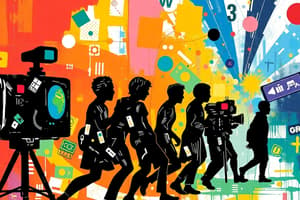Podcast
Questions and Answers
How do state-connected moguls affect media narratives in Egypt?
How do state-connected moguls affect media narratives in Egypt?
- By promoting independent journalism
- By aligning with governmental interests (correct)
- By enhancing press freedom
- By encouraging diverse viewpoints
What is a significant consequence of economic pressures on media outlets in Turkey?
What is a significant consequence of economic pressures on media outlets in Turkey?
- Self-censorship by journalists (correct)
- Increased public discourse
- Reduction in government control
- Enhanced journalistic freedom
What is a characteristic of Saudi Arabia's media landscape?
What is a characteristic of Saudi Arabia's media landscape?
- Flourishing of diverse viewpoints
- Economic backing from the state (correct)
- High levels of independent journalism
- Minimal government control
What impact do ambiguous legal frameworks have on media in MENA?
What impact do ambiguous legal frameworks have on media in MENA?
How does the lack of clear regulations affect digital media in the region?
How does the lack of clear regulations affect digital media in the region?
What concerns are raised by media regulation issues in MENA?
What concerns are raised by media regulation issues in MENA?
In the context of media governance, what is a necessary area of discussion?
In the context of media governance, what is a necessary area of discussion?
What is a common issue in the media landscape across the MENA region?
What is a common issue in the media landscape across the MENA region?
What role did print media play before the Arab Revolts?
What role did print media play before the Arab Revolts?
What development began to challenge state narratives in media before the Arab Spring?
What development began to challenge state narratives in media before the Arab Spring?
How did the media landscape change post-Arab uprisings?
How did the media landscape change post-Arab uprisings?
What was a major impact on media governance after the Arab uprisings?
What was a major impact on media governance after the Arab uprisings?
What characterized the media landscape before the Arab Spring?
What characterized the media landscape before the Arab Spring?
What type of regulatory mechanisms emerged post-Arab uprisings?
What type of regulatory mechanisms emerged post-Arab uprisings?
What can be inferred about the print media's function during the political discourse in the 1980s?
What can be inferred about the print media's function during the political discourse in the 1980s?
What is a significant characteristic of the media post-Arab uprisings?
What is a significant characteristic of the media post-Arab uprisings?
What is primarily limited in MENA countries due to centralized media controls?
What is primarily limited in MENA countries due to centralized media controls?
How did print media contribute to media dynamics before the Arab revolts?
How did print media contribute to media dynamics before the Arab revolts?
What factor limited competition and innovation in the media sector of MENA countries?
What factor limited competition and innovation in the media sector of MENA countries?
What emerged as a crucial source of insights into cultural perspectives in the Middle East?
What emerged as a crucial source of insights into cultural perspectives in the Middle East?
What primary role did academic sources and case studies serve in understanding media dynamics in the Middle East?
What primary role did academic sources and case studies serve in understanding media dynamics in the Middle East?
What is the primary focus of media policy?
What is the primary focus of media policy?
Which term describes the phenomenon where media structures reflect political frameworks?
Which term describes the phenomenon where media structures reflect political frameworks?
What impact do monolithic media systems typically have?
What impact do monolithic media systems typically have?
What is a key objective of media regulation?
What is a key objective of media regulation?
How do market mechanisms influence media?
How do market mechanisms influence media?
What characterizes Lebanon's media landscape?
What characterizes Lebanon's media landscape?
What is a potential consequence of stricter media regulations?
What is a potential consequence of stricter media regulations?
What influences how information is disseminated in the MENA region?
What influences how information is disseminated in the MENA region?
What is one primary role of state-controlled media in MENA countries?
What is one primary role of state-controlled media in MENA countries?
How does state media impact public opinion in MENA countries?
How does state media impact public opinion in MENA countries?
Which statement reflects a potential pitfall of state-controlled media?
Which statement reflects a potential pitfall of state-controlled media?
What is a global implication of media policies in MENA countries?
What is a global implication of media policies in MENA countries?
What role do media regulations play in international relations for MENA countries?
What role do media regulations play in international relations for MENA countries?
What is a notable aspect of Saudi Arabia's media policies?
What is a notable aspect of Saudi Arabia's media policies?
Which initiative is associated with Qatar's approach to media?
Which initiative is associated with Qatar's approach to media?
What is a common characteristic of media policies in MENA countries?
What is a common characteristic of media policies in MENA countries?
Flashcards are hidden until you start studying
Study Notes
Historical Context: Media Before the Arab Revolutions
- Early Media landscape: State control, colonial legacies, and limited space for dissent
- Print Media: Served as a platform for political expression, but was subject to heavy censorship
- Alternative Media (1990s): Emergence of satellite TV and the internet challenged state narratives
- Pre-Arab Spring: State-controlled media dominated, with limited independent voices
Media Policy Evolution Post-Arab Uprisings
- Authoritarian Restoration: Many regimes strengthened media control, reverting to authoritarian practices
- Fragmented Media Landscape: The media environment became fragmented with various outlets operating under different regulatory frameworks
- Ad Hoc Regulatory Mechanisms: Temporary regulations reflected the instability in governance, creating uncertainty for media organizations and journalists
- Impact on Media Governance: Reintroduction of stricter regulations and oversight mechanisms, limiting press freedom and stifling dissent
Key Concepts: Media Policy and Regulation
- Media Policy: Encompasses guidelines governing media operations, balancing freedom and regulation
- Public Policy: Shapes media regulation, influencing how information is disseminated in the region
- Governance Methods: State control and market mechanisms impact media freedom
- Regulation Objectives: Ensure ethical standards, protect national security, and promote cultural values
Structural Homology in Media and Political Fields
- Structural Homology: The idea that media structures reflect political frameworks, shaping public discourse
- Monolithic vs. Pluralistic Media: Monolithic media systems serve state interests, while pluralistic media promote diverse viewpoints and debate
- Case Study: Lebanon: Exhibits both pluralism and political manipulation, showcasing media complexities
Economic Implications of Media Control
- Economic Constraints on Media: Financial limitations impact content and independence, affecting public discourse
- Role of Media Moguls: State-connected moguls influence media narratives, often aligning with government interests
- Case Study: Egypt: The intersection of government control and economic interests limits journalistic freedom
- Case Study: Turkey: Economic pressures on media outlets lead to self-censorship and a restricted diversity of viewpoints
- Case Study: Saudi Arabia: Tightly controlled media backed by the state, leading to a lack of independent journalism and information access
Regulatory Bodies and Legal Frameworks
- Role of Regulatory Bodies: Shape the media landscape, often leading to censorship and biased reporting
- Legal Frameworks: Ambiguous legal frameworks enable arbitrary control, hindering press freedom and accountability
- Impact on Digital Media: The lack of clear regulations impacts digital platforms, limiting freedom of expression online
- Global Implications: These issues raise concerns about global perceptions of media freedom in the region
Impact of State-Controlled Media
- Role of State-Controlled Media: Serve as tools for the government, promoting policies and ideology
- Impact on Public Opinion: Media narratives influence public attitudes towards leadership
- Case Studies: MENA Countries: Examine specific examples like Egypt and Saudi Arabia to understand media's role
- National Unity Narratives: Media fosters a sense of unity, often sidelining dissenting voices and opinions
Global Implications of Media Policies
- Global Impact of Media Policies: Affect global perceptions, shaping narratives and influencing public opinion worldwide
- Role in International Relations: Media regulations act as tools for diplomatic relations and soft power
- Case Study: Saudi Arabia: Media policies reflect strategic interests, impacting both regional stability and international partnerships
- Case Study: Qatar: Media initiatives like Al Jazeera have redefined its influence, showcasing how media can alter global narratives
Media Policy
- State Monopolies in Broadcasting: MENA countries had centralized media controls, limiting diverse voices
- Role of Print Media: Print media served as a crucial outlet, but faced censorship
- Limited Private Sector Involvement: Minimal private sector influence restricted competition and innovation
Studying That Suits You
Use AI to generate personalized quizzes and flashcards to suit your learning preferences.




